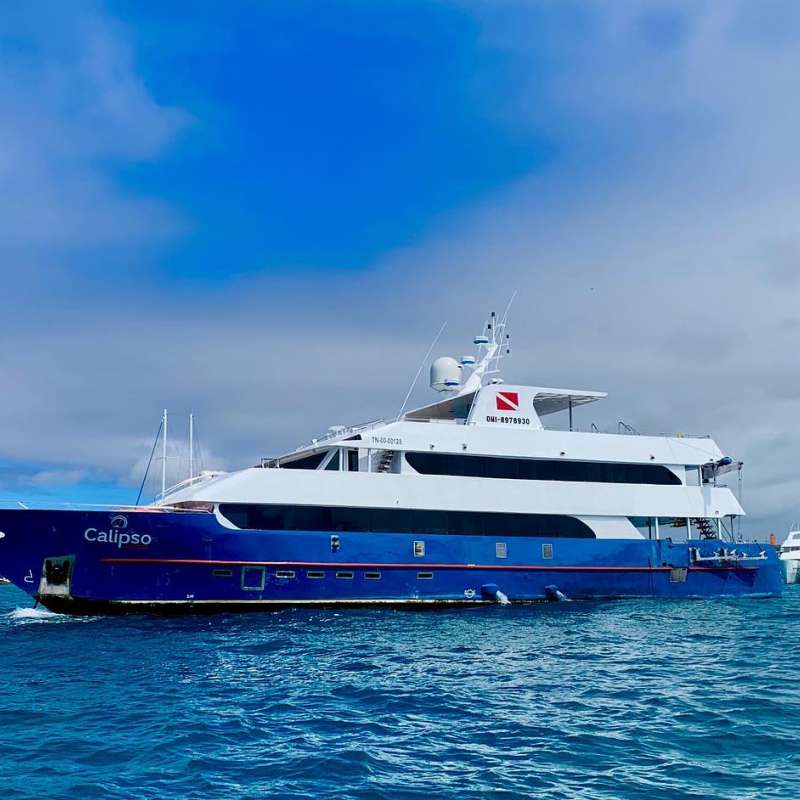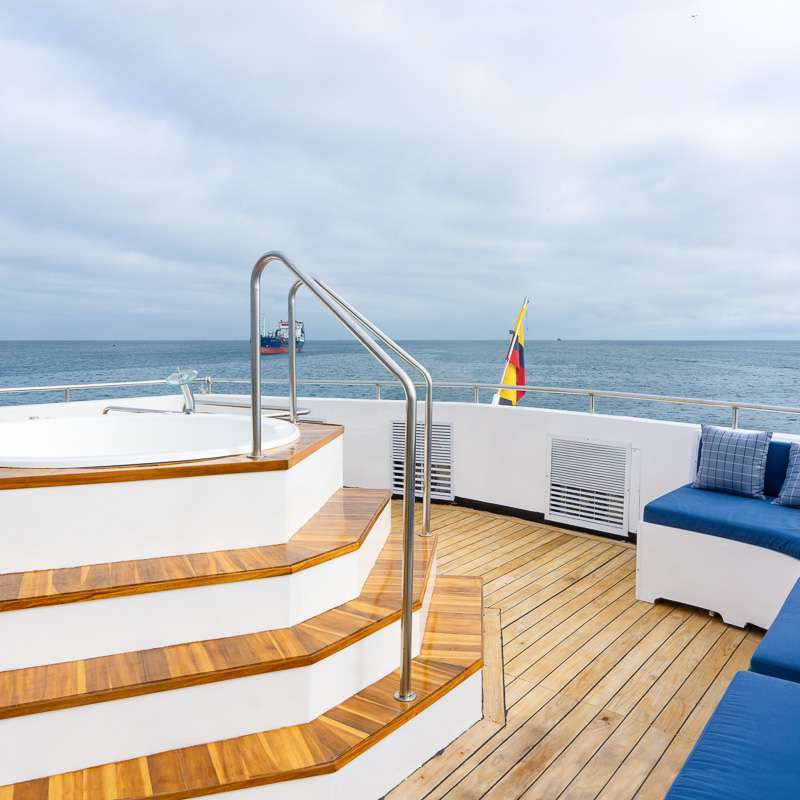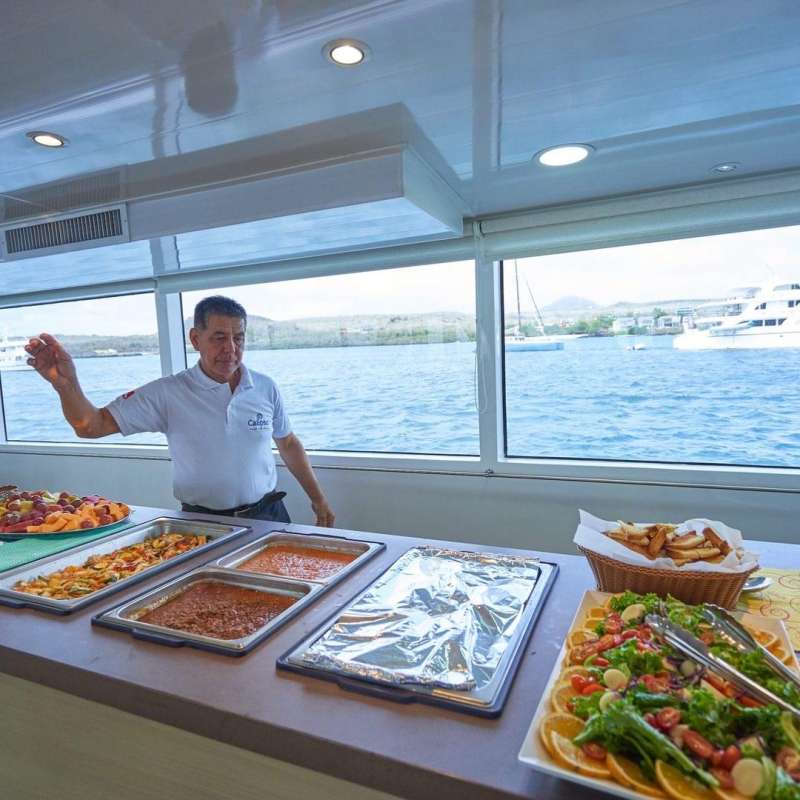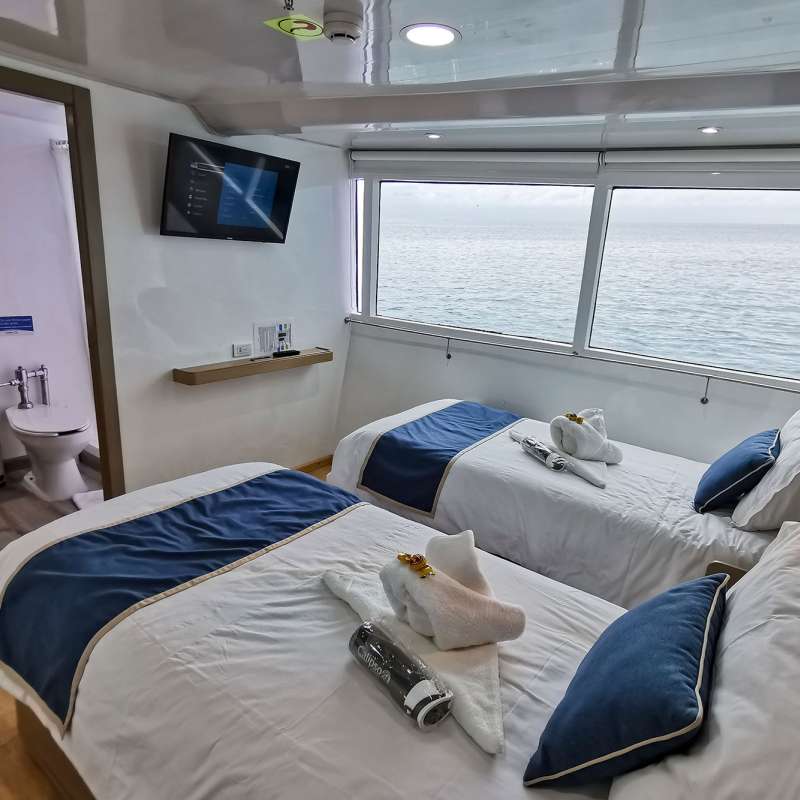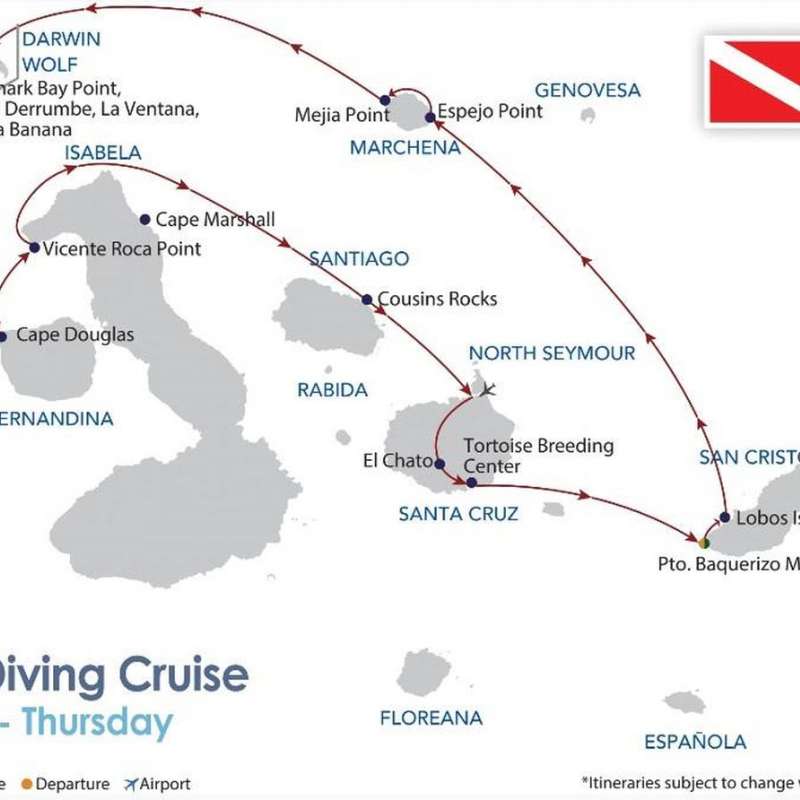Description
Boat
Calipso is a beautifully constructed Galapagos steel dive vessel from 2019, 35.4 meters in length and 8 meters in width, with crusing speed at 11 knots. It was originally built in 1991, and during 2018 - 2019, it was rebuilt again by a dive company in the Galapagos, onboard, everything is brand-new : All engines, generators, compressor, Nitrox membrane, electrical, plumbing...all systems are new. The dive deck is brand new. The interior and all exterior common areas are new.
Calipso features 4 decks in total : a new dive deck, a sun deck with Jacuzzi, a main deck with spacious salon with a large flat screen TV for briefings / movies and a comfortable dining area, and a cabin deck.
The meals onboard will never let you go hungry! Everyday will start with a Continental buffet prior to your first dive, then a full breakfast after the dive. Breakfast, lunch and dinner are served buffet style for all you can eat. Meals serve international and Ecuadorian dishes prepared with fresh local produce and seafood. There is a snack and hot beverage after each dive. Fruits, candies and snacks are available all day. If you have special dietary requests (vegetarian, vegan, gluten free, etc) as long as you submit them to us in a timely manner (90 days prior to arrival), the chef will try the best to accommodate your request!
Calipso also have a large dive platfrom located at the stern, with 4 hot showers, camera table and other dive facilities. The dry storage for charging camera batteries is along the wall shared with the interior salon. On the starboard side is the toilet and wetsuit racks. In the center of the deck and along the starboard side are the diver stations..
Cabin
Calipso has 10 deluxe cabins, it can only accommodate up to 16 guests per trip according to the National Park Policy:
All cabins have average 13 m2 / 140 sq.ft in size. Amenities include: Ensuite bath with hot water showers, individal climate control, TV with hundreds of films to choose from, hair dryers, safety deposit box, USB plugs and laminate flooring (no allergenic carpeting). Each cabin has 2 life jackets and a sprinkler system for safety.
6 Deluxe Cabins (#1- #6) :
Located on the upper deck, each cabin comes with two single beds side by side, also can be converted to queen bed, panoramic windows for views as well as a window in the bath.
2 Deluxe Cabins (#7 - #8) :
Located on the main deck, each cabin comes with two single beds side by side, also can be converted to queen bed, panoramic windows for views as well as a window in the bath.
2 Single Cabins (#9 - #10) :
Located on the lower deck, these two cabins are usually not for guest use. Each cabin comes with two single bed side by side, portholes. These cabins can be used as single cabins without single supplement. These are assigned on a first come, first serve basis, provide groups with flexibility, early takers as a single cabin or accommodate private dive guides.
Diving
3 dives per day + alternating additional sunset/night dives.
Usually 8D/7N diving trip will offer 18 - 20 dives in total.
1 Check dive will be provided on the embarkation day.
Only 1 - 2 dives will be provided on the last diving day.
All diving will provide experienced guide to lead the dive.
Divers must have AOW level with at least 50 logged dives.
Dive Alert, SMB, Nautilus Lifeline, Safety Noisemaker included.
Private guide is available for book in advance, with extra cost.
Other information
- Nitrox:Available with an additional cost
- 15L Tanks:Limited available with an additional cost
- Technical Dive Available:Not available at the moment
- REBREATHER Dive:Only available on dedicated charters
- Dive Equipment Rental:Available, rate on request
- Dive insurance:Divers must have valid dive insurance
- Wi-Fi Internet :Satellite wi-fi available free of charge
- Laundry Service: Available with an additional cost
- Massage Service:Not available at the moment
- Payment on board:By cash (USD) or credit cards.
- Crew Number:11, include 2 dive guides
Parcours ( V.O )
Calipso Galapagos Dive Itinerary
Day 1 - San Cristobal :
This morning, you will fly from the mainland of Ecuador to San Cristobal, Galapagos. Our guides will be there to greet you and escort you to the yacht. After getting settled in, we will have lunch and briefings followed by a check dive at Isla Lobos. Lobo is Spanish for wolf and sea lion is lobo del mar in Spanish. Expect to see sea lions. We sail to Marchena overnight.
Day 2 - Marchena Island:
Dive site Punta Espejo is located on the southeastern corner of Marchena, is typically only been dived by scientists and film makers. It is known for having very large pods of dolphins, schools of Hammerheads and Galapagos sharks. One film maker said he had never seen so many stingrays anywhere in the world. Other species include turtles, moray and garden eels, reef fish species and sometimes red lipped batfish in the sandy bottoms. 2 dives.
Dive site Punta Mejia is located on the northwestern side of Marchena, it is a shallow dive with many fish species, eels, rays and turtles. 1-2 dives, depending on timing. The group might opt for 1 dive and a panga ride as the geological formations are very interesting, again, depending on timing as we sail overnight to Wolf.
Day 3 - Wolf Island :
Wolf is one of the reasons Galapagos is on most divers’ bucketlist. Scientists have designated Wolf and Darwin (together as they are so close together) as the sharkiest place on earth because they have the largest biomass of sharks on the planet,
Sightings include huge schools of Hammerhead sharks, Galapagos sharks,Whale sharks (in season), Silky sharks, Eagle Rays, Sea Lions, Fur Seals, Mantas, Turtles, Jacks, Trumpetfish, Butterfly fish, Morish Idols, Moray Eels and Dolphins. Some sites at Wolf are covered in coral and all of the tropical fish species that live on coral reefs. Dive sites include Shark Bay, The Landslide, La Banana and Islote La Ventana. On the island itself, there are hundreds of thousands of seabirds including all 3 types of boobies in Galapagos – Red footed, blue footed and Nazca. There are frigates, pelicans, lava gulls and red billed tropicbirds.
Day 4 - Darwin Island :
Darwin’s Arch is an icon, the symbol of diving the Galapagos. It is located 229 km / 142 miles north of the central islands. In addition to Wolf, this is where we find massive schools of Hammerheads. Huge, pregnant Whale sharks pass through Darwin each year for reasons unknown.
Darwin is the warmest dive site in Galapagos due to the tropical Panama current. You spend a lot of the dive stationary, on a platform that drops into the blue where Hammerheads swim against the current. It’s like being on the side of a Hammerhead highway watching traffic pass. You leave the platform to swim out into the blue when a Whale shark is spotted. That sometimes means swimming through the Hammerheads, a truly magnificent experience you will carry with you forever.
Day 5 - Darwin Island > Walf Island :
We have 2 more dives at Darwin in the morning. We have 1-2 more dives at Wolf in the afternoon. There is an optional night dive at the Anchorage site. Anchorage has a sandy bottom where you may see garden eels and the red-lipped batfish.
Day 6 - Isabela Island or Fernandina Island :
JAN-MAY : Cabo Marshall (Isabela Island)
JUN-DEC : Cabo Douglas (Fernandina Island) + Punta Vicente Roca (Isabela Island)
Today is the only sites on liveaboard itineraries where you can see diving Marine Iguanas feeding underwater. You also see Penguins feeding on tiny silver Sardines using schools of Black Striped Salemas as cover. Turtles are especially abundant at Cabo Douglas which is probably why this is a likely location to site Orcas.
Punta Vicente Roca is a Mola Mola (Sunfish) cleaning station, has large turtle populations, the endemic Galapagos Bullhead shark, Penguins, Sea Horses, Sea Lions and many species of fish not found elsewhere in Galapagos. It is not uncommon to find yourself diving with an endemic Flightless Cormorant.
Day 7 - Cousins Rock > Santa Cruz Highlands :
Cousins Rock is a small rock, the remains of an eroded crater sticking up out of the sea. On the eastern side, the rock cascades down in a series of recessed ledges strewn with black coral, which is bright green under the water. Taking cover in the coral, you may find Seahorses, Frogfish, Octopus, Turtles and the elusive Longnose Hawkfish. It’s not unusual to spot pelagics from Cousins including Mantas, Eagle rays, Mobulas and Hammerhead. Sea lions are fur seals are also at Cousins.
Afternoon we will disembark head for a reserve in the Santa Cruz Highlands to see the iconic Galapagos Tortoise in its natural habitat. After the Highlands, we descend into the largest town in Galapagos, Puerto Ayora. You may opt to visit the Charles Darwin Research Center in the Galapagos National Park or wander about town. Our farewell dinner will be at a restaurant in Puerto Ayora. We then return to Calipso and sail to San Cristobal overnight.
Day 8 - San Cristobal :
You will disembark and are free to visit the Interpretation Center or wander around port before to the airport for your departure.
Plus
| Destinations | Galápagos |
|---|---|
| Disponible à bord | Support Nitrox, Station pour Photographe, Nautilus GPS, Jacuzzi, Wi-Fi |
| Langues parlées à bord | Anglais, Espagnol |
Horaires & trajets
Prix & conditions
Inclus
- Transferts de l'aéroport et/ou de l'hôtel au yacht
- TVA et taxes locales
- Formule repas pension complète (y compris les collations)
- Dispensaire d'eau, café instantané, thé
- Boissons non alcoolisées
- Activité de plongée (y bouteilles, ceinture et plombs)
- Guide de plongée
- Service de guides naturalistes
- Excursions terrestres et activités
- Assurance accident de bateau
- Serviettes de cabine et articles de toilette
- Service de nettoyage de cabine
- Wi-Fi
Non inclus
- Vols domestiques
- Frais de parcs marins et de port
- Supplément carburant
- Dîner la veille du débarquement
- Boissons alcoolisées
- Location d'équipement
- Bouteille 15L
- Nitrox
- Assurance de plongée (exigence obligatoire)
- Assurance de voyage
- Pourboires
Informations pratiques
Galápagos
Période: les croisières sont possibles toute l'année. néanmoins Il y a deux saison :
-De juin à novembre, la faune est abondante et il y a plus de chances de requin-baleine..
-De décembre à mai est la saison d'accouplement et également bonne pour les marteaux et raies manta.
Les visas: les citoyens de l'Australie, Nouvelle-Zélande, Japon, Union européenne, Canada et USA n'ont pas besoin de permis pour les séjours jusqu'à 90 jours. Les résidents de certains pays africains et asiatiques ont besoin de visas. Veuillez vérifier auprès de votre consulat équatorien le plus proche pour les conditions d'entrée actuelles.
Climat: bien que situé sur l'Équateur, la météo n'est pas tropicale. La saison plus froide et sèche s'étend de juin à novembre quand l'air est brumeux et les vents sont plus forts. La saison plus chaude, plus tropicale est entre décembre et mai.
-Pendant la saison sèche, la température de l'air est en moyenne entre 21° et 27°.
-Pendant la saison plus chaude, la température de l'air est en moyenne entre 24° et 32°.
Eau: En raison de fluctuations fréquentes du au courant dans la région, il y a toujours des thermoclines sous l'eau.
-Pendant la saison sèche, la température de l'eau varie de 16° à 24°.
-Pendant la saison plus chaude, la température de l'eau varie entre 21°à 28°.
Vêtements: des vêtements plus chauds pour les mois plus frais et des vêtements plus légers pour les mois ensoleillés et chauds. Aussi porter des pantalons longs et chemises à manches longues pour protection contre les piqûres de moustiques et les phlébotomes.
Fiches: Type A & B (US. / Canada) 120-127 V, 60 Hz
Vols: les vols internationaux arrivent directement à Quito ou à Guayaquil, avec des liaisons domestiques quotidiennes vers les Galápagos.
Devises: la monnaie locale est le Dollar américain. Les cartes de crédit Visa, Mastercard et Diners sont plus largement acceptées. Les distributeurs automatiques de billets sont disponibles a Santa Cruz et San Cristobal.
